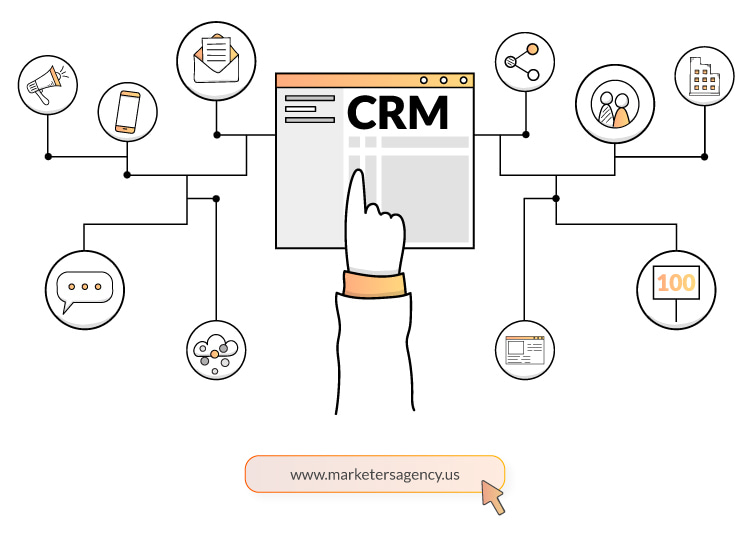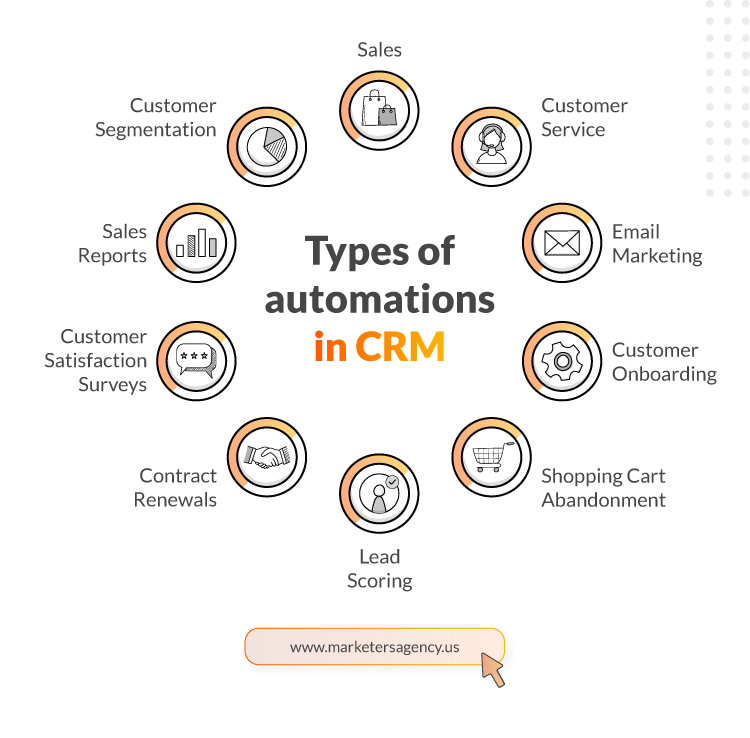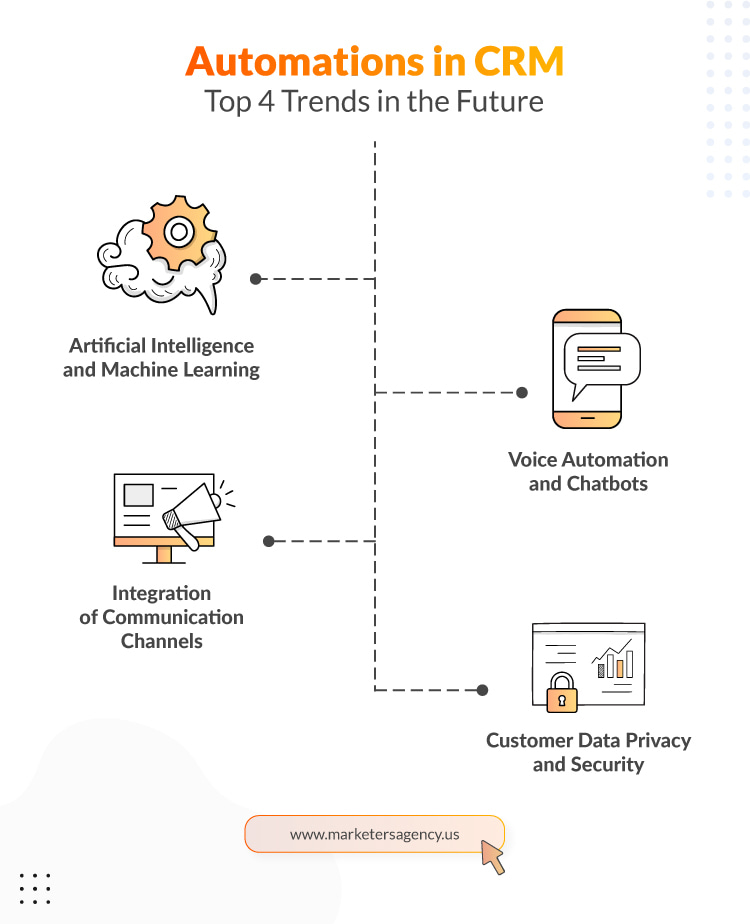CRM (Customer Relationship Management) refers to all the strategies, techniques, technologies, and systems that companies use to manage and analyze customer interactions and data throughout the customer lifecycle. The primary goal of CRM is to enhance business relationships with customers, aid in customer retention, and drive sales growth.
This is where CRM automations come into play, closely tied to Marketing Automation. They are essential for optimizing customer relationships as they can automate manual tasks and minimize human errors, ensuring an efficient workflow.
This article aims to delve into CRM automations, their significance, the benefits they offer, the various types available, the challenges in their implementation, and how to choose the right automated CRM solution. Additionally, it will address future trends in this field. If you have any doubts about what CRM is, I recommend checking out the previous link to better understand the tool we are discussing. Then, return to this article, which focuses exclusively on CRM automations and their various types.

What Are CRM Automations?
CRM automations are technologies that enable the automation of repetitive tasks and customer relationship management processes. Automations can involve everything from lead assignment to sales reps, sending marketing emails, tracking customer interactions, and collecting and analyzing customer data.
Automations are essential in customer relationship management because they allow for more personalized and efficient attention, which is a significant advantage in CRM. Automating repetitive tasks frees up time for employees to focus on customer interactions. Additionally, CRM automations provide valuable data that can be used to enhance the customer experience and inform business decisions.
Types of CRM Automations

Sales automation is a component of CRM that focuses on automating sales processes. It includes tasks such as automatically assigning leads to sales reps, tracking customer interactions, and closing sales.
The sales automation process begins with lead generation. Once leads are generated, the CRM system automatically assigns them to sales reps based on various criteria, such as geographic location or the sales rep’s area of expertise. The system can also send automated emails to leads to maintain interest and interaction.
CRM can also track customer interactions and automatically record relevant information. Finally, the system can assist in the sales closing process by providing sales reps with up-to-date customer information and reminding them of pending tasks.
Sales automation offers several benefits. First, it increases efficiency by relieving sales reps of repetitive tasks and allowing them to focus on interacting with customers. Second, it enhances consistency and accuracy in tracking customer interactions.
However, it also presents challenges. For example, sales reps may need training to learn how to use the CRM system. Additionally, implementing sales automation may require a significant initial investment.
Customer Service Automation
Customer service automation is another key component of CRM. It includes the automatic generation of support tickets, tracking customer interactions, and collecting and analyzing customer service data.
The customer service automation process begins when a customer contacts the company, whether by phone, email, or live chat. The CRM system can automatically generate a support ticket and assign it to the most suitable customer service agent.
CRM can also track customer interactions and automatically record relevant information. Additionally, it can collect and analyze data on customer service, such as response times and customer satisfaction.
Customer service automation can improve efficiency and consistency in customer service. However, its implementation may require an initial investment and significant training. Furthermore, there may be privacy and security issues in the collection and handling of customer data.
Email Marketing Automation
Email marketing automation is a technique that uses software to send emails to customers based on their behaviors and preferences.
This automation starts with the collection of data about customers, such as their purchase history and interactions with the company. This information is used to segment customers and send them personalized emails.
For example, if a customer has recently purchased a specific product, the system can automatically send an email with related products or usage suggestions for the purchased product.
Email marketing automation can increase the effectiveness of marketing campaigns by enabling large-scale personalization. However, it requires careful management to ensure that emails are not perceived as spam. Additionally, the handling of customer data must comply with privacy and security regulations.
Customer Onboarding Automation
Customer onboarding automation refers to the use of technology to guide new customers through the process of familiarizing themselves with a product or service.
The customer onboarding automation process may involve creating a series of emails or messages sent to new customers to help them understand and use a product or service. These messages can be personalized based on the customer’s needs and preferences.
This automation can enhance the customer experience and increase customer retention. However, it requires careful planning and design to ensure that the messages are relevant and genuinely helpful to customers.
Shopping Cart Abandonment Automation
Shopping cart abandonment automation refers to the use of technology to track customer behavior online and send automated emails to those who have abandoned products in their shopping cart without making a purchase.
The shopping cart abandonment automation process involves tracking customer behavior on the company’s website. If a customer adds products to their shopping cart but does not complete the purchase, the system can automatically send a reminder email.
Shopping cart abandonment automation can help recover lost sales. However, it must be handled carefully to avoid being perceived as invasive or annoying.
Lead Scoring Automation
Lead scoring is a crucial process in the sales funnel that involves evaluating the potential of leads or prospects that come to the company. This automation uses algorithms and predefined rules to assign a value to each lead based on various factors, such as their interaction with the company and demographic characteristics.
The lead scoring automation process may vary depending on the CRM tools used and the nature of the business. It generally involves defining a set of criteria and rules for scoring leads and scheduling the CRM to apply these rules automatically.
The primary benefit of lead scoring automation is the efficiency it brings to the sales process, as it eliminates manual work and allows sales teams to focus on the most promising leads. However, it can also present challenges, such as the need to define effective scoring criteria and to keep these criteria up-to-date as business circumstances change.
Contract Renewal Automation
Contract renewal automation involves the use of CRM systems to manage and facilitate the contract renewal process with customers.
In the contract renewal automation process, the CRM system can be programmed to send automatic reminders to both customers and the sales team as the contract renewal date approaches. Additionally, it can simplify the renewal process by generating and sending updated contract documents.
This automation can increase customer retention rates and improve operational efficiency. However, it may require careful implementation to ensure that reminders and contracts are generated and sent correctly.
Customer Satisfaction Survey Automation
The next automation we will discuss is customer satisfaction surveys, which involve the use of CRM systems to efficiently and systematically generate and send surveys to customers.
The customer satisfaction survey automation process typically includes creating surveys using tools integrated into the CRM itself, scheduling surveys to be automatically sent after certain touchpoints or events, and collecting and analyzing survey results.
This type of automation can streamline the collection and analysis of customer feedback, which can lead to improvements in the customer experience. However, companies must be careful not to overload customers with surveys and ensure that data collection complies with all relevant privacy and security regulations.
Sales Reporting Automation
Sales reporting automation involves the use of CRM systems to generate sales reports that provide valuable insights into sales performance, trends, and business opportunities.
This automation process relies on configuring custom reports in the CRM, which are generated and updated automatically based on real-time sales data. These reports can then be automatically distributed to relevant stakeholders.
Among the advantages of this automation is the ability to provide a quicker and more accurate view of sales performance, greatly enhancing decision-making. However, it may require careful setup and management to ensure that the reports are accurate and useful.
Customer Segmentation Automation
Customer segmentation is one of the most important processes we will discuss, as its purpose is to divide a company’s customer base into distinct groups that share similar characteristics. Customer segmentation automation involves the use of algorithms and predefined rules to perform this process automatically.
It’s worth noting that the customer segmentation automation process may vary depending on the CRM tools used and the specific needs of the business. It typically involves defining a set of criteria for each customer segment and programming the CRM to apply these criteria to the company’s customer base automatically.
Customer segmentation automation can facilitate marketing personalization and targeting, often resulting in increased customer satisfaction and marketing effectiveness. However, it can also present challenges, such as the need to define effective segmentation criteria and to keep these criteria up-to-date as business circumstances change.
How to Choose an Automated CRM Solution
Choosing the right CRM for your company that can provide suitable automated solutions can be a daunting task due to the wide variety of options available. Therefore, we will provide you with some tips to simplify this process and ensure that you select the tool that best fits your company’s needs.
Identify the company’s needs and goals
Before starting to look for CRM solutions, it is crucial to identify the specific needs and goals of your company. Are you looking to improve the efficiency of the sales team, personalize the customer experience, or both? Do you need a solution that integrates easily with your current systems? Once you have a clear understanding of what you want to achieve with your CRM, you can start evaluating different solutions based on how they align with these needs and goals.
Evaluating Different CRM Solutions in Terms of Features, Ease of Use, Scalability, and Cost
Once you have identified your needs and goals, it’s time to start evaluating different CRM solutions. When doing so, consider factors such as the platform’s features, ease of use, scalability, and cost.
Keep in mind that the features should align with your business objectives. For example, if customer personalization is a priority, look for a solution with robust segmentation and personalization capabilities.
Ease of use is crucial to ensure that your team adopts the tool correctly. If the platform is too complicated, your team is less likely to use it effectively, leading to suboptimal results. This is especially relevant in CRM reporting, as not all tools have features that assist in report generation.
Another factor to consider is scalability, which is important to ensure that the solution can grow with your company. Lastly, cost should also be a factor in your decision. Look for a solution that offers a good balance between cost and functionality.
Consider Integrations with Other Systems
In addition to the CRM solution’s features, it’s also important to consider how it will integrate with other systems and tools your company already uses. A good CRM solution should seamlessly integrate with tools such as email systems, marketing software, social media platforms, and other software systems your company utilizes.
Request Demonstrations or Free Trials
Once you have selected some potential CRM solutions, request demonstrations or free trials. This will allow you to see the platform in action and get a clear idea of what it would be like to use it on a day-to-day basis. During the demonstration, pay close attention to factors such as ease of use and how well the platform’s features align with your company’s needs and objectives.
Seek References and Read User Reviews
Before making a final decision, don’t forget to seek references from the CRM company and read user reviews. This will give you an idea of the experiences other companies have had with the platform and may reveal potential issues or limitations that were not apparent during the demonstration. Keep in mind, however, that every company is different, so a solution that works well for one company may not be the best fit for another.
Future Trends in CRM Automation

CRM automation is constantly evolving, with new technologies and approaches continuing to shape the landscape. Looking ahead, there are several key trends that are emerging and are likely to play a significant role in how companies use CRM automation in the coming years.
Artificial Intelligence and Machine Learning for Enhanced Personalization and Predictive Analysis
Artificial intelligence (AI) and machine learning (ML) are playing an increasingly important role in CRM automation. These technologies allow companies to analyze large volumes of customer data and use that data to personalize customer interactions in more sophisticated ways.
Additionally, AI and machine learning can be used for predictive analysis, enabling companies to anticipate customers’ future needs and behaviors based on their past actions and interactions. This can enable even greater personalization and help companies be more proactive in their customer service approach.
Voice Automation and Chatbots for Improved Customer Service
Another emerging trend in CRM automation is the use of voice automation and chatbots to enhance customer service. Chatbots can handle a large number of customer interactions, freeing up customer service staff to address more complex issues.
Voice automation, on the other hand, is making it easier for companies to interact with customers through voice-enabled devices, such as smart voice assistants. This can allow companies to be present on more channels and provide customers with additional ways to interact with them.
Integration of Communication Channels for a Unified Customer Experience
As customers interact with businesses through an increasingly diverse range of channels, it’s becoming more crucial that these experiences are integrated and provide a unified customer experience. This means that regardless of how or where a customer interacts with your company, they should receive a consistent level of service and a coherent experience.
This may require greater integration between different CRM automation systems, as well as an increased ability to collect and effectively analyze data from different channels.
A Greater Focus on Customer Data Privacy and Security
Lastly, as CRM automation becomes more advanced and companies collect and use more customer data, the privacy and security of this data are becoming an increasingly significant concern. Companies must ensure that they are complying with all relevant regulations regarding data protection and privacy, and they must take measures to safeguard customer data from threats like data breaches. This is likely to remain a key area of focus in the future of CRM automation.
Conclusion
CRM automations are essential for effectively managing customer relationships. Although their implementation can present challenges, the benefits in terms of efficiency, personalization, and data-driven decision-making make the investment worthwhile.
When selecting an automated CRM solution, your company should carefully consider its needs and objectives, as well as the features and cost of different solutions. Additionally, you should stay vigilant for future trends in CRM automation, such as artificial intelligence and integrated communication channels.


